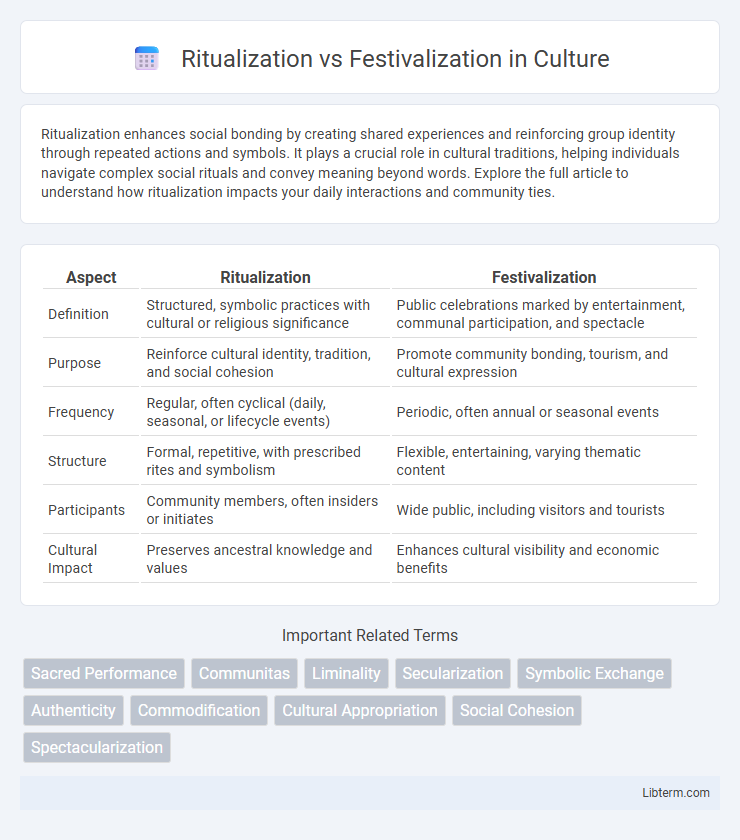Ritualization enhances social bonding by creating shared experiences and reinforcing group identity through repeated actions and symbols. It plays a crucial role in cultural traditions, helping individuals navigate complex social rituals and convey meaning beyond words. Explore the full article to understand how ritualization impacts your daily interactions and community ties.
Table of Comparison
| Aspect | Ritualization | Festivalization |
|---|---|---|
| Definition | Structured, symbolic practices with cultural or religious significance | Public celebrations marked by entertainment, communal participation, and spectacle |
| Purpose | Reinforce cultural identity, tradition, and social cohesion | Promote community bonding, tourism, and cultural expression |
| Frequency | Regular, often cyclical (daily, seasonal, or lifecycle events) | Periodic, often annual or seasonal events |
| Structure | Formal, repetitive, with prescribed rites and symbolism | Flexible, entertaining, varying thematic content |
| Participants | Community members, often insiders or initiates | Wide public, including visitors and tourists |
| Cultural Impact | Preserves ancestral knowledge and values | Enhances cultural visibility and economic benefits |
Defining Ritualization and Festivalization
Ritualization involves the systematic practice of repetitive actions embedded with symbolic meaning, serving to reinforce social norms and collective identity. Festivalization refers to the transformation of cultural, religious, or social events into larger-scale, often commercialized festivals that attract wide public participation. Both concepts highlight different dimensions of cultural expression, with ritualization emphasizing tradition and continuity, while festivalization focuses on spectacle and communal celebration.
Historical Origins of Rituals and Festivals
Ritualization traces its origins to ancient religious and social practices designed to establish order, reinforce community bonds, and transmit cultural values across generations. Festivalization evolved from these ritualistic foundations, expanding into large-scale public celebrations that emphasize collective identity and seasonal or historical commemorations. Archaeological evidence from Mesopotamia and ancient Egypt highlights how rituals became formalized ceremonies, while festivals grew into complex events blending sacred rites with communal entertainment.
Key Characteristics of Ritualization
Ritualization involves structured, repetitive actions embedded with symbolic meaning, often serving to reinforce social norms and collective identity. Key characteristics include formalized procedures, adherence to tradition, and emotional engagement that fosters group cohesion and continuity. This process emphasizes stability and continuity, contrasting with festivalization's focus on spontaneity and celebration.
Main Features of Festivalization
Festivalization emphasizes large-scale public celebration characterized by vibrant cultural expressions, extensive community participation, and a focus on entertainment and spectacle. It often involves elaborate performances, thematic decorations, and commercial activities that enhance tourism and local economies. This process transforms traditional rituals into accessible, inclusive events designed to attract diverse audiences beyond their original cultural or religious contexts.
Cultural and Social Functions
Ritualization entails structured practices deeply rooted in cultural traditions that reinforce social norms, collective identity, and community cohesion. Festivalization transforms these rituals into large-scale public events emphasizing entertainment, economic benefits, and tourism, often broadening inclusivity but sometimes diluting original cultural meanings. Both processes contribute uniquely to social functions by preserving heritage while adapting to contemporary societal dynamics.
Transformations in Modern Societies
Ritualization emphasizes structured, symbolic actions deeply rooted in tradition and cultural identity, while festivalization centers on public, often commercialized celebrations that foster social cohesion and economic activity. Transformations in modern societies reflect a shift from solemn, community-bound rituals to dynamic, inclusive festivals that serve as platforms for cultural expression and tourism. This evolution highlights the growing importance of media, urbanization, and globalization in reshaping social practices and collective experiences.
Impact on Community Identity
Ritualization strengthens community identity by reinforcing shared values, traditions, and cultural continuity through repeated symbolic actions, fostering a sense of belonging and collective memory. Festivalization transforms community identity by introducing dynamic, often commercialized events that promote cultural diversity and social interaction while attracting external attention and tourism. Both processes shape community cohesion but differ in sustaining authenticity versus adapting to broader social and economic influences.
Commercialization and Globalization Effects
Ritualization often maintains traditional significance and cultural authenticity, resisting commercialization despite increasing globalization pressures that demand adaptability. Festivalization tends to emphasize large-scale events driven by commercial interests, prioritizing economic benefits and global appeal over original ritual meanings. The global marketplace encourages festivalization to transform rituals into entertainment spectacles, thus expanding reach but diluting cultural specificity.
Ritualization vs Festivalization: Key Differences
Ritualization emphasizes repeated, structured actions with symbolic meaning deeply rooted in tradition and community identity, while festivalization centers on large-scale, often commercialized celebrations designed to attract diverse audiences and boost tourism. Ritualization fosters continuity and social cohesion through prescribed ceremonies, whereas festivalization prioritizes entertainment value and economic impact. The key difference lies in ritualization's focus on cultural preservation and spiritual significance, compared to festivalization's emphasis on spectacle and mass participation.
Contemporary Examples and Case Studies
Ritualization emphasizes repetitive, symbolic practices ingrained in cultural or religious traditions, exemplified by Japan's tea ceremony or India's Diwali rituals, where preservation of meaning and participation longevity are paramount. Festivalization, by contrast, denotes the transformation of events into large-scale, commercialized festivals like Brazil's Carnival or Germany's Oktoberfest, highlighting entertainment, tourism, and economic impact over traditional symbolism. Contemporary case studies reveal how urban interventions harness ritualization to strengthen community identity while festivalization often accelerates urban regeneration and global visibility through spectacle and mass engagement.
Ritualization Infographic

 libterm.com
libterm.com